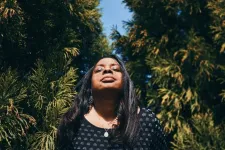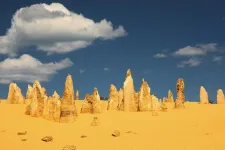Filament structure activates and regulates CRISPR-Cas ‘protein scissors’
Vilnius University researchers unveil the mechanism of CRISPR-Cas ‘protein scissors’
2024-10-02
(Press-News.org)
CRISPR-Cas systems help to protect bacteria from viruses. Several different types of CRISPR-Cas defense systems are found in bacteria, which differ in their composition and functions. Among them, the most studied proteins today are Cas9 and Cas12, also known as DNA or ‘gene scissors’, which have revolutionized the field of genome editing, enabling scientists to edit genomes and correct disease-causing mutations precisely.
Researchers from the Institute of Biotechnology at the Life Sciences Center of Vilnius University – Dalia Smalakytė, Audronė Rukšėnaitė, Dr Giedrius Sasnauskas, Dr Giedrė Tamulaitienė, and Dr Gintautas Tamulaitis – have revealed the structure of the CRISPR-Cas ‘protein scissors’ found in bacteria and provided mechanistic details on how they function. The results of their study have been published in the prestigious and highly cited journal Molecular Cell.
A team of researchers led by Dr Tamulaitis is studying the bacterial defense system CRISPR-Cas10, which acts as a sensor. When a virus attacks the bacterium, it sends a ‘message’ by synthesizing unique signal molecules called cyclic oligoadenylates. These signaling molecules are recognized by different effectors, i.e. accessory proteins in the system that enhance the bacterial defense against viruses. A recent computational analysis predicted that CRISPR-Cas10 effectors may have diverse enzymatic activities, allowing bacteria to defend themselves against viruses in multiple ways.
‘The discovery of cyclic oligoadenylates and the understanding of the mechanism of CRISPR-Cas10 have sparked great scientific interest and a breakthrough in signaling pathway research. Recently, a similar protection principle has been identified in other bacterial defense systems: CBASS, Pycsar, and Thoeris. In this study, we investigated the tripartite CalpL-CalpT-CalpS effector which is activated by CRISPR-Cas10 signaling molecules and we explained how this complex system works and how it is regulated,’ explains Dr Tamulaitis.
The CalpL-CalpT-CalpS effector consists of three key proteins: CalpL, which acts as a signal-recognizing ‘protein scissors’; CalpS, a protein that regulates gene expression; and CalpT, an inhibitor of the CalpS protein. The Vilnius University researchers used a combination of biochemical, biophysical, bacterial survivability assays, and cryogenic electron microscopy (cryo-EM) to study this system. They found that when CalpL binds a molecule that signals a viral infection, it forms a polymeric filament of variable composition. The filament structure allows the CalpT-CalpS heterodimer to attach, positioning the active center of the ‘scissors’ CalpL near the inhibitor CalpT and enabling to cleave it. Once CalpT is cleaved, CalpS is released from the heterodimer and can regulate gene expression to protect the bacterium from viral infection.
One of the authors, Dalia Smalakytė, points out that the activity of the CRISPR-Cas ‘protein scissors’ is tightly regulated in time. The ‘protein scissors’ have an internal timer mechanism that is activated upon the binding of signaling molecules and filament formation. This mechanism is unique compared to other similar signal-sensing effector proteins.
The newly discovered mechanism of the CRISPR-Cas10 system illustrates the complexity of the bacterial defense system. These studies pave the way for the practical application of the regulated CRISPR-Cas ‘protein scissors’ as a molecular indicator of infection.
‘Molecular Cell’ is one of the flagship scientific journals of ‘Cell Press/Elsevier’, publishing outstanding research in molecular biology.
The study presented in this article received funding from the Research Council of Lithuania (LMTLT), agreement No S-MIP-22-9 (Principal Investigator Dr Tamulaitis).
END
[Attachments] See images for this press release:

ELSE PRESS RELEASES FROM THIS DATE:
2024-10-02
Global evidence has revealed that women’s environmental quality of life is key to their overall quality of life and health, according to a study published October 2, 2024, in the open-access journal PLOS ONE by Suzanne Skevington from the University of Manchester, U.K., and colleagues.
Gender inequalities in health-related quality of life are generally few and small, even in large surveys. Yet many generic measures limit assessment to quality of life overall and its physical and psychological dimensions, while overlooking internationally important environmental, ...
2024-10-02
A new analysis assesses the heterogeneity of factors linked with happiness among single Americans who are just entering adulthood, highlighting a particularly strong link between happiness and satisfying friendships. Lisa Walsh of the University of California, Los Angeles, U.S., and colleagues present these findings in the open-access journal PLOS ONE on October 2, 2024.
Prior research suggests that Americans in their early 20s may be less happy, on average, than at other points in their lives. Meanwhile, a growing percentage of young adults are not in long-term romantic relationships, and researchers are increasingly studying single people as a distinct ...
2024-10-02
Wild banana relatives of mainland Southeast Asia reveal hidden diversity and the urgent need to preserve nature’s genetic resources for future crops
###
Article URL: https://journals.plos.org/plosone/article?id=10.1371/journal.pone.0307592
Article Title: Musa species in mainland Southeast Asia: From wild to domesticate
Author Countries: France, U.S., Vietnam, Lao P.D.R., China
Funding: This study was funded by the Sud Expert Plantes Développement Durable programme through the DivBa SEP2D project (AAP3-97) and the BforBB open science project supported by the Agropolis Fondation under the reference ID 1605-011 through the “Investissements ...
2024-10-02
A century of data uncovers how chestnut blight has devastated the American chestnut - and how forest composition has evolved since - in Shenanoah National Park, Virginia
###
Article URL: https://journals.plos.org/plosone/article?id=10.1371/journal.pone.0306748
Article Title: Floristic changes following the chestnut blight may be delayed for decades
Author Countries: U.S.
Funding: We were funded by the Washington Biologists’ Field Club. This is a small organization that gives out only a few small awards each year. We do not have a specific grant number associated with this award. ...
2024-10-02
Migration in adolescence may double the risk of psychosis in later life, and present even larger risk for migrants from racially minoritized young people, new data from five European countries suggests.
####
Article URL: https://journals.plos.org/mentalhealth/article?id=10.1371/journal.pmen.0000134
Article Title: Age-at-migration, ethnicity and psychosis risk: Findings from the EU-GEI case-control study
Author Countries: Brazil, Canada, France, Italy, the Netherlands, Spain, United Kingdom
Funding: The EU-GEI Study was funded by grant agreement HEALTH-F2-2010-241909 (Project EU-GEI) from the European ...
2024-10-02
Small iron-rich formations found within Western Australia’s Pinnacles, which are part of the world’s largest wind-blown limestone belt spanning more than 1000km, have provided new insights into Earth’s ancient climate and changing landscape.
The new research found the pinnacles were formed about 100,000 years ago during what was the wettest period in the past half-million years for the area, and very different from the Mediterranean climate Western Australia experiences today.
Lead author ...
2024-10-02
Countries affected by severe climate change may also have a higher prevalence of violence against women, finds a new study led by UCL researchers.
The research, published in PLOS Climate, examined how climate shocks – such as storms, landslides and floods – might be linked to higher rates of intimate partner violence in the two years following the event.
The researchers gathered data on intimate partner violence from 363 surveys conducted in 156 countries between 1993 and 2019, focusing on women who currently had a partner. Intimate partner violence was defined as any physical and/or sexual violence in ...
2024-10-02
Networks, which include nodes and connections, can help researchers model dynamic systems like the spread of disease or how the brain processes information. Pairwise interactions between nodes can represent links between individuals — how two neurons connect with one another in the brain, for example — but scientists also study interactions involving three or more nodes. These higher-order interactions reveal changes and phenomena beyond those found by looking only at pairs.
Yuanzhao Zhang, an SFI Complexity Postdoctoral Fellow, has studied how higher-order ...
2024-10-02
Researchers at Karolinska Institutet have identified a new potential risk marker for cardiovascular disease in women. A new study shows an association between low levels of an anti-inflammatory antibody and the risk of heart attack and coronary heart disease. The study is published in the Journal of American College of Cardiology.
Cardiovascular disease is the leading cause of death for both women and men in Sweden. However, research on women's heart health has historically been neglected. Women are affected later in life and have more risk factors such ...
2024-10-02
Climate change-related landslides, storms and floods are associated with intimate partner violence against women two years after the event, according to a study published October 2 in the open-access journal PLOS Climate by Jenevieve Mannell from University College London and colleagues.
Low- and middle-income countries are disproportionately impacted by climate change’s acute (e.g., flooding) and chronic (e.g., rising sea levels) effects. Countries undergoing climate shocks are more likely to see increased intimate partner violence against women, possibly because climate disasters ...
LAST 30 PRESS RELEASES:
[Press-News.org] Filament structure activates and regulates CRISPR-Cas ‘protein scissors’
Vilnius University researchers unveil the mechanism of CRISPR-Cas ‘protein scissors’







